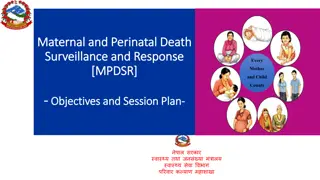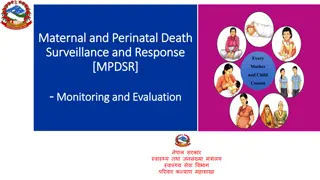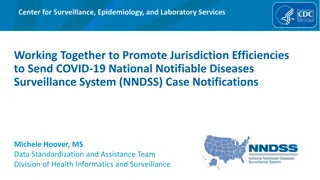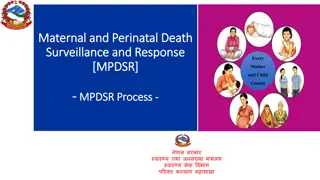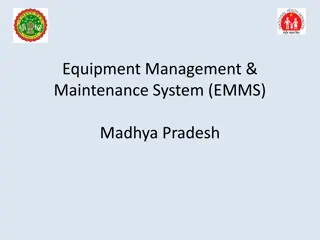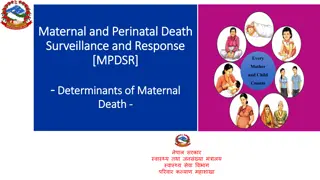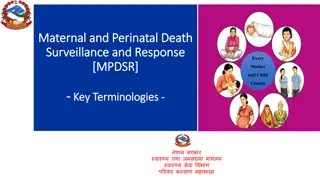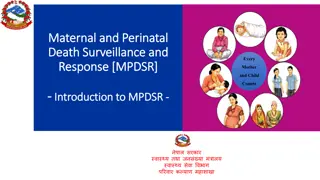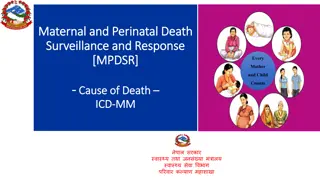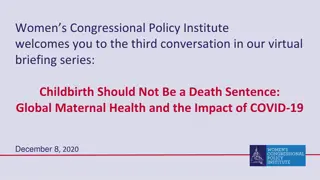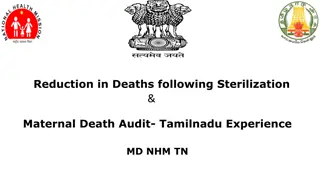Maternal Death Surveillance and Response in Madhya Pradesh During COVID-19
Madhya Pradesh faces challenges in reducing maternal mortality rates, especially during the COVID-19 pandemic. Despite initiatives like the Maternal Death and Surveillance Review program, compliance at the district level has been lacking. To address this, online interventions and state-level reviews involving key officials were implemented to ensure a focus on Maternal Death Surveillance and Response (MDSR) during the pandemic. These efforts aim to intensify maternal death reviews, analyze cases, and involve relevant stakeholders for improving maternal health outcomes in the state.
Download Presentation

Please find below an Image/Link to download the presentation.
The content on the website is provided AS IS for your information and personal use only. It may not be sold, licensed, or shared on other websites without obtaining consent from the author.If you encounter any issues during the download, it is possible that the publisher has removed the file from their server.
You are allowed to download the files provided on this website for personal or commercial use, subject to the condition that they are used lawfully. All files are the property of their respective owners.
The content on the website is provided AS IS for your information and personal use only. It may not be sold, licensed, or shared on other websites without obtaining consent from the author.
E N D
Presentation Transcript
Bringing to forefront Maternal Death Surveillance and Response during COVID-19 Pandemic Madhya Pradesh National Health Mission Department of Public Health and Family Welfare Madhya Pradesh
MADHYA PRADESH DEMOGRAPHIC PROFILE Area 3 Lakh Sq Km Population Census 2011 7.2 Crore %Scheduled Tribes 20.8 %Scheduled Castes 15.6 Districts 51 Development Blocks 313 Tribal Blocks 89 %Literacy 70.60 Density of Population 236 per Sq. Km. Sex Ratio at Birth 925 (SRS 2016-18)
RATIONALE Madhya Pradesh is the 2ndlargest state with 3rdhighest MMR in the country MMR is 173 per 1,00,000 live births (SRS 2016-2018) Rate of decline in MMR is less than desired (SDG goal of reduction of global MMR to 70 per 1,00,000 live births by 2030) State level Maternal Death and Surveillance Review (MDSR) program initiated in 2015-16, completed the state and district level orientation Districts did not show satisfactory compliance to the MDSR program even after repeated instructions and reviews by state. During COVID 19 Pandemic MDSR program became more neglected.
Maternal Mortality Ratio (MMR) Trends: India & M.P. 400 335 350 300 254 221 250 173 200 167 150 113 100 50 0 2004-06 2011-13 2016-18 India Total Madhya Pradesh Average Annual Rate of Reduction (AARR) of Maternal Mortality Ratio (MMR) for Madhya Pradesh is 5.51 and to achieve SDG 2030 goals required AARR is 6.96
INTERVENTION AT A GLANCE Online maternal death reviews from state level in presence of higher officials to keep focus on MDSR during COVID pandemic. Online State Level MDR Review Meeting chaired by Hon ble Health Minister, Additional Chief Secretary, Commissioner, Mission Director & Additional Mission Director NHM and Deputy Director Maternal Health
INTERVENTION AT A GLANCE Online MDSR intervention intensified in April 2020 Online 78 maternal deaths reviewed at state level Overall status of maternal deaths, in depth review of selected cases and near miss cases Concerned district officials including Gynecologists, MOs, Staff Nurses, ANMs, Blood Bank Incharges, LTs etc. attend the review along with the faculty from Medical Colleges and Regional Team
PROCESS OF MDSR AT STATE LEVEL Three major activities performed:- Presentation on division wise MDSR status by two Regional Directors on rotation. Presentation of two Maternal death case per division. Presentation of two near miss cases.
Process of Divisional MDSR Status Every month two divisions are identified for presentation on divisional MDSR status review by state A presentation template for divisional reviews shared by state Regional directors with support of regional RMNCHA Coordinator collect the data and enter on the template Referral cases to Regional Medical Colleges and place of maternal death included in the presentation Regional Directors present the divisional MDSR status updates in presence of Medical College faculties
Process of Review of Maternal Death Cases Every month two maternal death cases (mostly with preventable cause) per division are identified for state level review List of MDR cases and a template for MDR presentation shared with districts Districts conduct CBMDR, FBMDR and share findings in presentation form State level officers review the cases based on supporting documents prior to MDSR meeting District level officers present the case during state level Maternal death review
Process of Near-Miss Case Review Details of Near-miss cases invited from districts Districts share the brief description of management of near miss cases Selection of two near-miss cases Treating Doctors and Nursing Staff present the case
MATERNAL DEATH REPORTING AND REVIEW STATUS % of Maternal Deaths Reported and Reviewed 81 78 90 80 56 70 47 60 35 50 30 40 19 30 11 6 20 10 0 % of Maternal Deaths reported % of FBMDR conducted % of CBMDR Conducted 2018-19 2019-20 2020-21 (till Dec 2020)
CAUSE WISE ANALYSIS OF MATERNAL DEATHS (n=873) Division wise leading cause of Maternal death PPH is leading cause of maternal mortality in Obstetric Haemorrhage- APH 4% Gwalior division (29%) and Sagar division (27%) Obstetric Haemorrhage- PPH 20% Hypertensive disorders are leading cause for Others 32% maternal mortality in Jabalpur division (27%) Anemia is responsible for 25% of maternal deaths in Rewa division and 23% in Gwalior division. PIH/Pre- eclampsia/Eclam psia 18% Other causes are higher in Bhopal (44%) and Anaemia as an underlying cause 17% Indore (46%) division. Sepsis/ Septic shock 8% Abortion and its complications 1% Focus on Quality of MDR in Bhopal and Indore division.
KEY OBSERVATIONS OF THE MDR DATA ANALYSIS 74% of maternal deaths among less than 25 year of age women. 56% of deceased women primigravida 64% of deceased women registered in 12 weeks 50% of deceased women not received any ANC service by MOs. Only 26% of deceased women detected as high risk during ANC period by ANM/MO. Abdominal examination done in only 20% of deceased women and urine albumin in 58%. 54% of HRP detected at the time of admission
Gaps identified during MDSRs and corrective action taken Field Level Gaps related to ANC Services: HRP tracking and monitoring Quality of ANC services at VHNDs Quality ANC services at facilities Logistics at VHNDs Corrective Action Taken: Customized RCH portal has been developed to track HRPs Establishment of Integrated Command and Control Centre (ICCC) at state to track all HRPWs Online training of more than 8000 ANMs in quality ANC services completed Gaps of logistics fulfilled in a structured way by utilizing untied funds of HWC, SHC and VHSNC Digital Haemoglobinometers (cuvette based) provided to 4000 CHOs and at 149 delivery points for accuracy Foetal doppler provided to 5278 ANMs of aspirational and HPD districts to accurately measure FHR Approx. 2000 CHOs are trained to deliver quality ANC services and administration of IV iron Sucrose injections HRP clinics are organized on every Friday to provide specialist care to HRP women.
Gaps identified during MDSRs and corrective action taken Facility Level Gaps related to Delivery Services: Availability of Human Resources at delivery points Clinical skills of the nursing staff and MOs at delivery points Quality services at delivery points Blood transfusion services Anaemia a leading cause of Maternal mortality Corrective Action Taken: Process of recruitment of more than 2500 staff nurses under NHM Dakshata Trainings initiated in all districts Total 290 facilities selected to certify under LaQshya program Bulk licensing of Blood Storage Units completed by the blood cell of the directorate of health services Organization of Blood donation camps to ensure availability of blood in BSUs and Blood Banks Inj. FCM is administered to more than 2500 PNC mothers and a research study approved to generate evidence related to safety issues of Inj. FCM in ANC period
Other Actions Taken Planned Birth waiting home in FRUs Inservice CPS diploma course initiated and DNB course planned in DH Individual monitoring of the specialists for regular functionality of FRUs 29 sanctioned obstetric HDUs out of them 17 are functional , remaining will be functional by the end of FY 2020-21 Collaboration with Medical Education Department for better coordination between new Medical Colleges and District Hospitals running in the same campus for averting unindicated referrals




